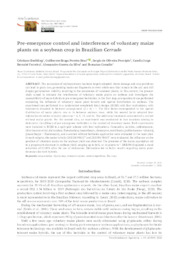Pre-emergence control and interference of voluntary maize plants on a soybean crop in Brazilian Cerrado.
Pre-emergence control and interference of voluntary maize plants on a soybean crop in Brazilian Cerrado.
Author(s): BUCHLING, C; BRAZ, G. B. P.; PROCOPIO, S. de O.; FERREIRA, C. J. B.; SILVA, A. G. da; CORADIN, J.
Summary: Abstract: The succession of soybean/maize has been largely adopted. Storm damage and crop problems can lead to grain loss, generating maize ear fragments or even whole ears that remain in the soil and still display germination viability, resulting in the occurrence of volunteer plants. In this context, the present study aimed to evaluate the interference of voluntary maize plants on soybean and investigate the susceptibility of maize hybrids to pre-emergence herbicides. In the first step, an experiment was performed evaluating the influence of voluntary maize plant density and spatial distribution on soybean. The experiment was performed in a randomized completely block design (RCBD) with four replications, with treatments disposed in factorial arrangement (2 x 4) + 1. The first factor corresponded to the spatial distribution of maize plants: row or in between soybean rows; while the second factor adopted four infestation densities of maize plants m-2: 4, 8, 12, and 16. The additional treatment consisted of a control without maize plants. For the second step, an experiment was conducted in two locations aiming to determine the efficacy of pre-emergence herbicides in the control of voluntary maize. Both experiments were installed in RCBD in a split-plot scheme with four replications. Fomesafen, lactofen, sulfentrazone, chlorimuron-ethyl, diclosulam, flumetsulam, imazethapyr, clomazone, metribuzin, [sulfentrazone + diuron], [imazethapyr + flumioxazin], and a control without herbicide application were evaluated in the main plot. In each subplot, the maize hybrids DKB310 PRO3? and DKB390 PRO3? were evaluated. No influence on the position of voluntary maize on the soybean yield was observed. The presence of the maize population led to a progressive decrease in soybean yield, ranging up to 86%, at 16 plants m-2. DKB390 displayed a stand reduction of 82.88% after the use of diclosulam. Diclosulam led to better results regarding maize plant decreases for both hybrids.
Publication year: 2022
Types of publication: Journal article
Unit: Embrapa Environment
Observation
Some of Embrapa's publications are published as ePub files. To read them, use or download one of the following free software options to your computer or mobile device. Android: Google Play Books; IOS: iBooks; Windows and Linux: Calibre.
Access other publications
Access the Agricultural Research Database (BDPA) to consult Embrapa's full library collection and records.
Visit Embrapa Bookstore to purchase books and other publications sold by Embrapa.

